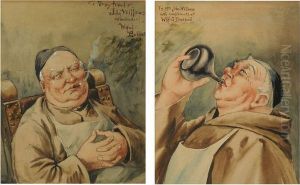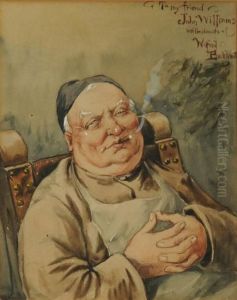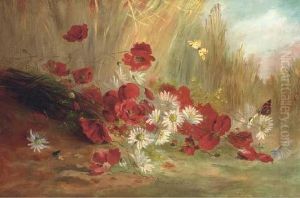Wilfred Buckland Paintings
Wilfred Buckland was not an artist in the traditional sense of painters or sculptors, but he was indeed an artist of the silver screen. Born in 1866, Buckland was a pioneering figure in the field of art direction and production design in the early days of American cinema. He brought his background in architecture and stage design to the burgeoning film industry and is often credited with being one of the first to introduce the concept of 'mood' to film sets, treating them as integral elements of storytelling rather than mere backdrops.
Before venturing into the world of film, Buckland trained as an architect and worked as a stage designer for theatrical impresario David Belasco. His work in theater, where he was celebrated for his innovative use of lighting and space to enhance the narrative, caught the attention of film director Cecil B. DeMille. In the early 1900s, when the film industry was still in its infancy, DeMille invited Buckland to join him in Hollywood to work on films.
Buckland made a significant impact on the visual style of films during the silent era. He was the art director for DeMille's 'The Squaw Man' in 1914, which is considered the first feature-length film made in Hollywood. His ability to create grand and expressive settings that complemented the film's narrative helped set a new standard for production design. He went on to work on other classic films, including 'Joan the Woman' in 1916 and 'Robin Hood' in 1922, where his attention to historical detail and visual spectacle were highly regarded.
Despite his contributions to the film industry, Buckland's career waned with the advent of talking pictures. The shift in industry priorities and perhaps Buckland's resistance to the changing landscape of cinema led to fewer opportunities for him. He continued to work on several projects throughout the 1920s and 1930s, but his influence and reputation did not reach the heights of his earlier career.
Tragically, Wilfred Buckland's life came to a mysterious and abrupt end in 1946, when he was found dead in an apparent murder-suicide pact with his gardener, in his Los Angeles home. Despite the tragic end and the somewhat obscured memory of his contributions, Buckland's legacy as a pioneer in the art of production design remains significant. He helped to lay the foundations for the visual storytelling that has become a hallmark of the cinematic experience.


